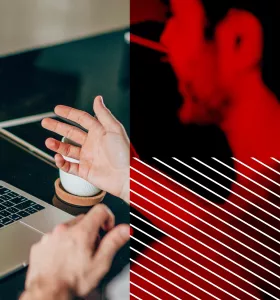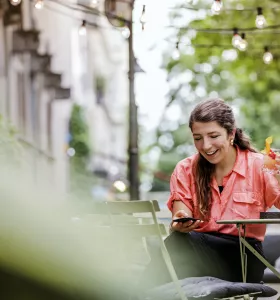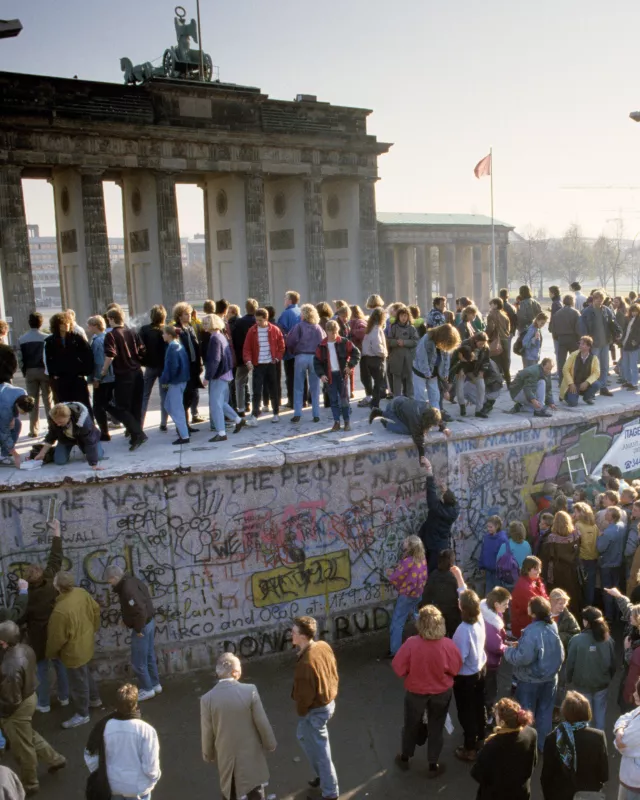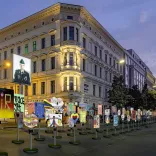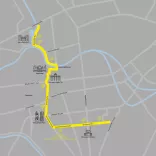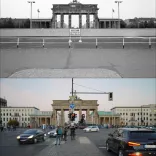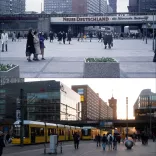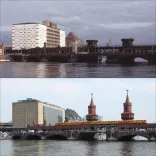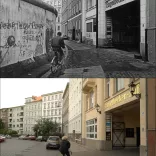Berlin celebrates 35 years since the fall of the Berlin Wall
Thousands of voices for freedom
Berlin, 9 October 2024 In a month's time, Berlin, the city of freedom, will celebrate 35 years since the fall of the Berlin Wall with a spectacular programme under the motto ‘Hold freedom up high!’.
The centrepiece of the celebrations is a four-kilometre-long open-air installation along the former inner-city course of the Wall with thousands of historical and newly designed posters. The programme will be complemented by special exhibitions at prominent points, a diverse supporting programme with talks, concerts and a closing concert by Pussy Riot as well as a large joint concert by bands and visitors: On the evening of 9 November, the street will be transformed into probably the biggest stage in the world with 1,000 musicians along the entire route.
In recent weeks, visitBerlin has been intensively promoting a visit to Berlin for the celebrations internationally, for example in the UK, Poland, the Czech Republic, Hungary, Ireland, Romania, Sweden, Belgium and Portugal.
Our central special pages for the anniversary to inform Berlin's guests are
visitBerlin.de/en/35-years-fall-berlin-wall and
visitBerlin.de/en/berlin-wall
More than three decades after its fall, the Berlin Wall still attracts travellers from all over the world. Berlin commemorates its past as a divided city in many places. In 2023, the Berlin Wall Memorial and Topography of Terror were among the top 10 most visited museums and memorials. East Side Gallery, Parliament of Trees or Invalidenfriedhof: in this newsletter, we introduce you to a wide variety of places where you can go in search of traces. You can also experience the history of the city with our story app ‘About Berlin’.
Have fun exploring the city
Your media team from visitBerlin
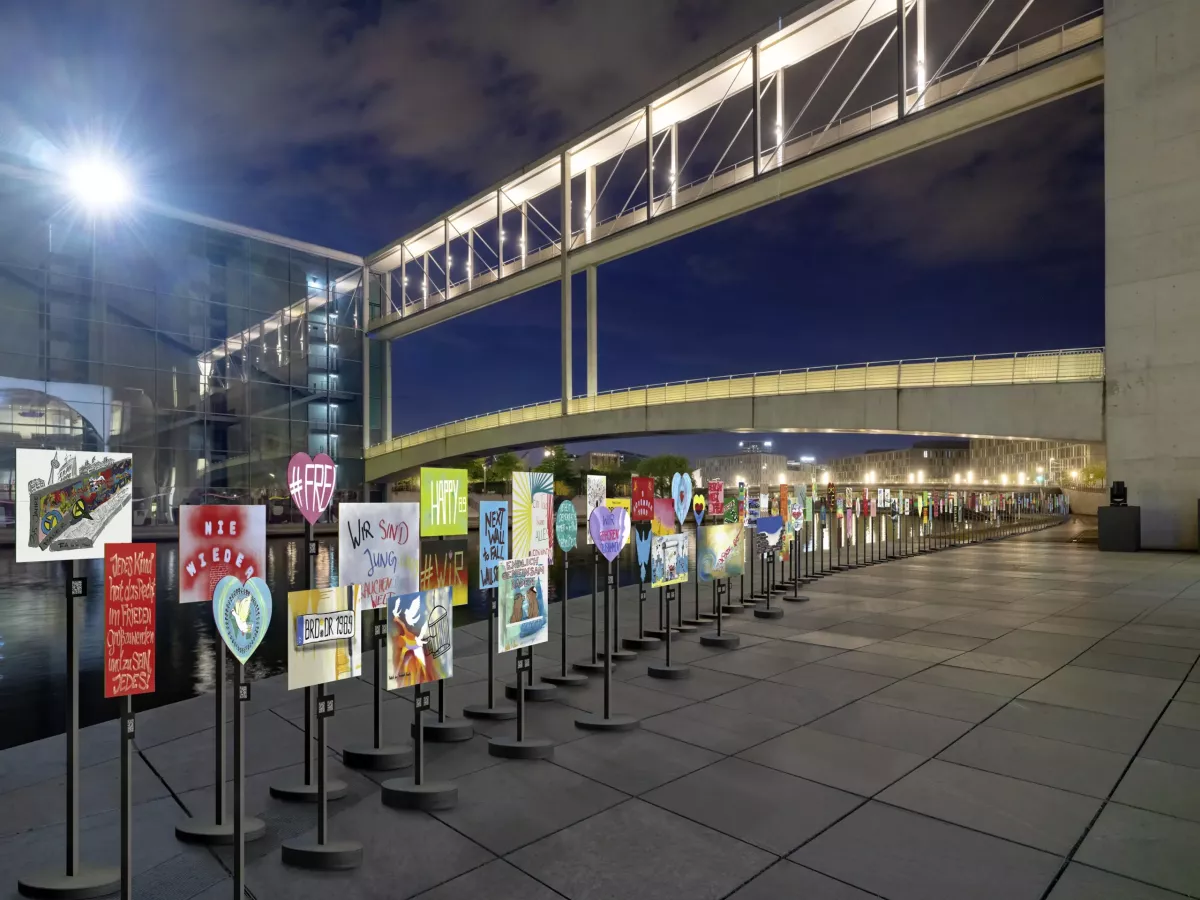
Poster installation: Remembering and celebrating on the anniversary weekend

A four-kilometre-long open-air presentation along the former inner-city course of the Wall between Invalidenstraße and Axel-Springer-Straße forms the heart of the celebrations on 8 and 9 November 2024. Thousands of historical and newly designed posters combine the demands of 1989/90 with current wishes for freedom and democracy.
Special exhibitions at seven stations: At prominent points such as the Brandenburg Gate and Checkpoint Charlie, themed exhibitions make the events of 1989/90 tangible through photos, interviews and reports.
‘Band for Freedom": The highlight is a spectacular wall of sound on the evening of 9 November. Hundreds of musicians and the public will perform the ‘Soundtrack of 1989’ along the route - a unique experience, including ‘Heroes’ by David Bowie, ‘People Have the Power’ by Patti Smith, ‘z.B. Susann’ by City and ‘Freiheit’ by Marius Müller-Westernhagen.
Supporting programme: The weekend also offers talks, concerts, readings and hands-on activities. A special highlight: Pussy Riot will give a closing concert in front of the former Stasi headquarters.
Find out more: mauerfall35.berlin and visitBerlin.de/en/event/35-jahre-friedliche-revolution-und-mauerfall
Events to mark the 35th anniversary of the fall of the Berlin Wall
Berlin invites all visitors to a series of events throughout the city to celebrate the values of freedom and democracy: exhibitions, events, interactive programmes and guided tours along the former border strip. Highlights include a diverse special programme under the motto ‘Remembering the Revolution | Shaping Democracy’ by the Berlin Wall Foundation, a photo exhibition at C/O Berlin, the exhibition ‘Hin und Weg. The Palace of the Republic is Present’ at the Humboldt Forum and the Campus for Democracy: on 10 November, the former Stasi headquarters will host a programme on the fall of the Berlin Wall that will shed light on historical perspectives.
visitBerlin's story salon & evening event
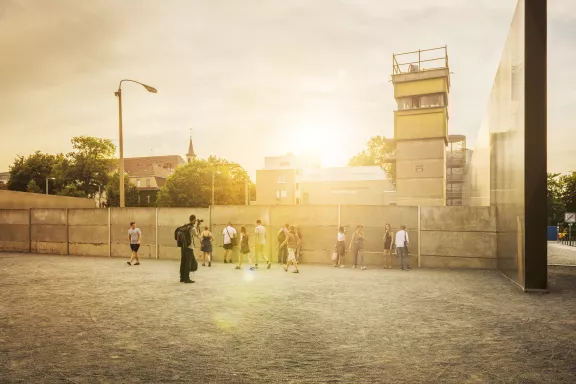
visitBerlin itself is also organising events to mark the anniversary of the fall of the Berlin Wall: on 25 October and 12 November, 4 to 6:30 pm, a story salon on the subject of ‘Life behind the Berlin Wall’ will take place at the Berlin Wall Memorial (Visitor Centre), offering the opportunity to bring the history of the divided city to life through the personal experiences of contemporary witnesses. Details here.
In addition, visitBerlin is organising an exclusive evening event to commemorate what is probably the most important historical event in our city - the fall of the Wall. The event will honour those involved in the peaceful revolution of 1989 and at the same time pay tribute to those who are still fighting for freedom and democracy around the world today. In addition to contemporary witnesses and civil rights activists, the guests will also include players from national and international politics, society, culture, business and the media. The patron of the event is the Governing Mayor of Berlin.
Experience the Berlin Wall
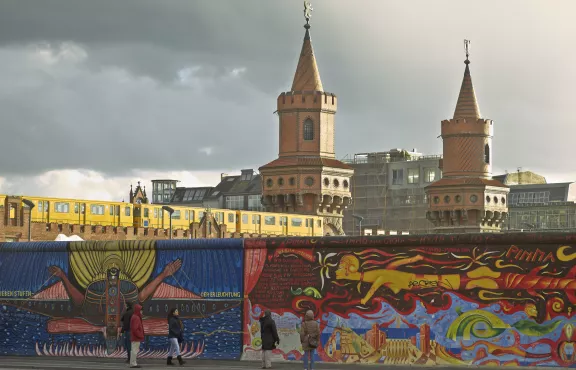
Construction of the Berlin Wall started on 13th August, 1961. It changed a nation overnight. The Wall - it symbolises a divided city, a divided country, the Cold War. Although it was built over six decades ago, it is still very much alive in many places. For instance at the East Side Gallery, the world's longest open-air gallery. This art mile stretches for 1,316 metres along the banks of the River Spree in Friedrichshain, making it the longest continuous section of the Wall. 100 works of art document the political developments of the years of upheaval. Especially popular: the brother’s kiss by Dimitrji Vrubel or the Trabant breaking through the wall by Birgit Kinder.
Equally impressive is the Parlament der Bäume gegen Gewalt und Krieg, which is located on the banks of the River Spree opposite the Reichstag building. Artist Ben Wagin created this memorial site in 1990 on the site of the former border strip of the Berlin Wall. He worked on 58 sections of the wall for this, granite slabs commemorate 258 victims of the Wall who died at the inner-German border. The centrepiece of the memorial site is a square of 16 trees planted by the 16 German prime ministers in 1990 - the actual Parliament of Trees (Parlament der Bäume).
There are two important places in Mitte that convey Berlin's history impressively. The Gedenkstätte Berliner Mauer on the former border strip comprises four theme stations with historical audio and visual material, a visitor centre and an observation tower. There is a 70 metre long section of the Berlin Wall with a border strip and a watchtower on Bernauer Straße. The sector border also ran through the Invalidenfriedhof at the time. More than 90 per cent of the graves had to make way for the death strip with its watchtowers, control strips, the running track for the guard dogs and the patrolling road. Parts of around 180 metres of the former hinterland wall have been preserved here.
Tracing the Berlin Wall

On foot or by bike: The Berliner Mauerweg absolutely worth it on fine autumn days. It marks the course of the former GDR border fortifications to West Berlin and runs for 155 kilometres around the former half-city. The Berliner Mauerweg is divided into 14 individual stretches that are between seven and 21 kilometres long. Historically interesting sections with remains or traces of walls alternate with scenic stretches. One possible tour, for example, goes from Wollankstraße to Nordbahnhof or from Potsdamer Platz to Warschauer Brücke.
And if the weather doesn't co-operate? Then you can still trace the Berlin Wall, for instance in the Mauermuseum – Haus am Checkpoint Charlie. Visitors travel back in time to a divided Berlin. Rainer Hildebrandt founded the Mauermuseum in 1962, which he used to document the escape plans of GDR citizens. Original objects such as an old Volkswagen with a hiding place in the boot, a mini-submarine, a hot air balloon and a pushed-together suitcase relate these escape attempts.
Even the Tränenpalast provides insights into personal stories. In 1962, the GDR built a terminal building at Friedrichstraße station, which was used for departures from East to West Berlin. Friends and families said goodbye in the glass and steel pavilion - mostly in tears. The permanent exhibition “Site of German Division” commemorates these fates.
What did an autumn day in 1980s Berlin look like? This is shown by the huge panoramic image “DIE MAUER – das asisi Panorama zum geteilten Berlin”. In the 360° installation room, artist Yadegar Asisi portrays everyday life on both sides of the Wall.
And another museum is dedicated to the divided Berlin. The “Die Mauer I The Wall” museum opened on Leipziger Platz in 2020 displays exhibits such as uniforms, newspaper cuttings, firearms, badges and old telephone and communication equipment.
More: Tracing the Berlin Wall
Listen to Berlin's history
The podcast “Berlin Unboxed” from visitBerlin offers new perspectives on the city. “The night the Wall fell” is the title of this edition of our contemporary witness interview: visitBerlin Managing Director Burkhard Kieker met Ewald König on the occasion of the 35th anniversary of the fall of the Wall - an Austrian journalist who was an observer of reunification and the only correspondent accredited in both the FRG and the GDR. This episode and other contemporary witness stories about Berlin as a city of the fall of the Wall, change and freedom can be seen and heard here in the video.
In episode 7 “Berlin Unboxed – Der Sound der Freiheit mit Mark Reeder”, the British musician and Berliner-by-choice talks about the music scene and club culture of the 1980s, punk rock in the GDR and East and West Berlin. And about why Berlin's music scene stands for the sound of freedom.
More Berlin stories for the ears
Berlin's history in an app
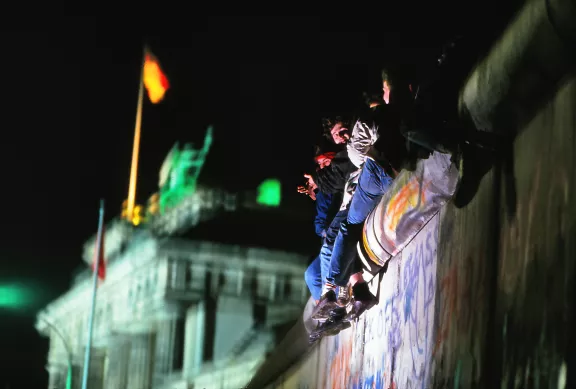
If you want to learn more about the Wall and the divided city, the ABOUT BERLIN app from visitBerlin is an inspiring resource. The story ‘Bösebrücke: Bridge to freedom - the night the Wall fell’ tells the story of a very special night: 9 November 1989, when the German-German border ran right through the middle of the bridge. The history of the Hotel Adlon is also moving. The story ‘Hotel Adlon: Grand Hotel away from the Berlin Wall’ traces the decline of the magnificent building. Audio and video material bring both stories to life.
Further information & before and after photos of the fall of the Berlin Wall
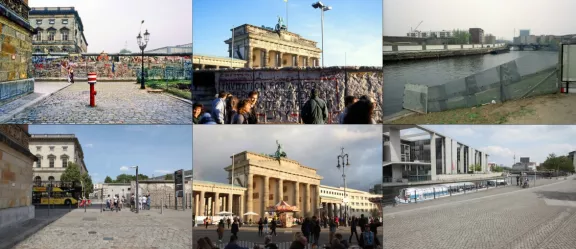
To mark the anniversary of the fall of the Berlin Wall, photographer Jo Furch has juxtaposed a number of places here.
You can find images on our website in the Download section and for current press releases, press here. Our visitBerlin blog provides even more inspiration. Please contact us if you have any questions.
